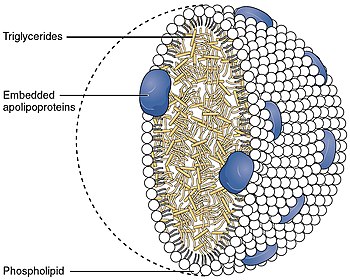Remnant cholesterol, also known as remnant lipoprotein and triglyceride-rich lipoprotein cholesterol is an atherogenic lipoprotein composed primarily of very low-density lipoprotein (VLDL) and intermediate-density lipoprotein (IDL) with chylomicron remnants.[1][2][3] Elevated remnant cholesterol is associated with increased risk of atherosclerotic cardiovascular disease and stroke.[3][4]
Definition
[edit]Remnant cholesterol is the cholesterol content of triglyceride-rich lipoproteins, which comprise of very low-density lipoproteins and intermediate-density lipoproteins with chylomicron remnants.[2][5] Remnant cholesterol is primarily chylomicron and VLDL, and each remnant particle contains about 40 times more cholesterol than LDL.[6]
Remnant cholesterol corresponds to all cholesterol not found in high-density lipoprotein (HDL-C) and low-density lipoprotein (LDL-C). It is calculated as total cholesterol minus HDL-C and LDL-C.[7]
Health effects
[edit]Elevated remnant cholesterol is associated with an increased risk of atherosclerotic cardiovascular disease, chronic inflammation, myocardial infarction and stroke.[4][5][8][9] Remnant cholesterol is especially predictive of coronary artery disease in patients with normal total cholesterol.[10][11]
High plasma remnant cholesterol is associated with increased plasma triglyceride levels.[12] Hypertriglyceridemia is characteristic of high plasma remnant cholesterol, but persons with high plasma triglycerides without high remnant cholesterol rarely have coronary artery disease.[13]
Remnant cholesterol has about twice the association with ischemic heart disease as LDL cholesterol.[14] Although remnant cholesterol tends to be higher in people who are overweight (high body mass index), normal-weight persons with high remnant cholesterol tend to have a higher risk of myocardial infarction.[15]
Lowering remnant cholesterol
[edit]Vupanorsen, an ANGPTL3 inhibitor has been shown to lower remnant cholesterol up to 59%.[16]
See also
[edit]References
[edit]- ^ Jørgensen AB, Frikke-Schmidt R, West AS, Grande P, Nordestgaard BG, Tybjærg-Hansen A (2013). "Genetically elevated non-fasting triglycerides and calculated remnant cholesterol as causal risk factors for myocardial infarction". European Heart Journal. 34 (24): 1826–1833. doi:10.1093/eurheartj/ehs431. PMID 23248205.
- ^ a b Davidson, Michael H. (2018). "Triglyceride-rich lipoprotein cholesterol (TRL-C): the ugly stepsister of LDL-C". European Heart Journal. 39 (7): 620–622. doi:10.1093/eurheartj/ehx741.
- ^ a b Davidson, Michael H. (2020). Therapeutic Lipidology. Springer. pp. 139–158. ISBN 978-3-030-56513-8.
- ^ a b Yang XH, Zhang BL, Cheng Y, Fu SK, Jin HM. (2023). "Association of remnant cholesterol with risk of cardiovascular disease events, stroke, and mortality: A systemic review and meta-analysis". Atherosclerosis. 371: 21–31. doi:10.1016/j.atherosclerosis.2023.03.012. PMID 36966562.
{{cite journal}}: CS1 maint: multiple names: authors list (link) - ^ a b Nordestgaard BG (2016). "Triglyceride-Rich Lipoproteins and Atherosclerotic Cardiovascular Disease: New Insights From Epidemiology, Genetics, and Biology". Circulation Research. 118 (4): 547–563. doi:10.1161/CIRCRESAHA.115.306249. PMID 26892957.
- ^ Dallinga-Thie GM, Kroon J, Borén J, Chapman MJ (2016). "Triglyceride-Rich Lipoproteins and Remnants: Targets for Therapy?". Current Cardiology Reports. 18 (7): 67. doi:10.1007/s11886-016-0745-6. PMC 4877422. PMID 27216847.
- ^ Stürzebecher, Paulina E; Katzmann, Julius L; Laufs, Ulrich (2023). "What is 'remnant cholesterol'?". European Heart Journal. 44 (16): 1446–1448. doi:10.1093/eurheartj/ehac783.
{{cite journal}}: CS1 maint: multiple names: authors list (link) - ^ Varbo A, Nordestgaard BG (2014). "Remnant cholesterol and ischemic heart disease". Current Opinion in Lipidology. 25 (4): 266–273. doi:10.1097/MOL.0000000000000093. PMID 24977981.
- ^ Goliasch G, Wiesbauer F, Blessberger H, Demyanets S, Wojta J, Huber K, Maurer G, Schillinger M, Speidl WS (2015). "Premature myocardial infarction is strongly associated with increased levels of remnant cholesterol". Journal of Clinical Lipidology. 9 (6): 801–6.e1. doi:10.1016/j.jacl.2015.08.009. PMID 26687701.
- ^ Masuoka H, Kamei S, Wagayama H, Ozaki M, Kawasaki A, Tanaka T, Kitamura M, Katoh S, Shintani U, Misaki M, Sugawa M, Ito M, Nakano T (2000). "Association of remnant-like particle cholesterol with coronary artery disease in patients with normal total cholesterol levels". American Heart Journal. 139 ((2 Pt 1)): 305–310. doi:10.1016/j.atherosclerosis.2008.05.024. PMID 10650304.
- ^ Nakamura T, Kugiyama K (2006). "Triglycerides and remnant particles as risk factors for coronary artery disease". Current Atherosclerosis Reports. 8 (2): 107–110. doi:10.1007/s11883-006-0047-3. PMID 16510044.
- ^ Chapman MJ, Ginsberg HN, Amarenco P, Andreotti F, Borén J, Catapano AL, Descamps OS, Fisher E, Kovanen PT, Kuivenhoven JA, Lesnik P, Masana L, Nordestgaard BG, Ray KK, Reiner Z, Taskinen MR, Tokgözoglu L, Tybjærg-Hansen A, Watts GF, European Atherosclerosis Society Consensus Panel (2011). "Triglyceride-rich lipoproteins and high-density lipoprotein cholesterol in patients at high risk of cardiovascular disease: evidence and guidance for management". European Heart Journal. 32 (11): 1345–1361. doi:10.1093/eurheartj/ehr112. PMC 3105250. PMID 21531743.
- ^ Fujioka Y, Ishikawa Y (2009). "Remnant lipoproteins as strong key particles to atherogenesis". Journal of Atherosclerosis and Thrombosis. 16 (3): 145–154. doi:10.5551/jat.E598. PMID 19556722.
- ^ Varbo A, Benn M, Tybjærg-Hansen A, Jørgensen AB, Frikke-Schmidt R, Nordestgaard BG (2013). "Remnant cholesterol as a causal risk factor for ischemic heart disease". Journal of the American College of Cardiology. 61 (4): 427–436. doi:10.1016/j.jacc.2012.08.1026. PMID 23265341.
- ^ Varbo A, Freiberg JJ, Nordestgaard BG (2018). "Remnant Cholesterol and Myocardial Infarction in Normal Weight, Overweight, and Obese Individuals from the Copenhagen General Population Study". Clinical Chemistry. 64 (1): 219–230. doi:10.1373/clinchem.2017.279463. PMID 29021326.
- ^ Zimerman A, Wiviott SD, Park JG, Murphy SA, Ran X, Bramson CR, Curto M, Ramos V, Jevne A, Kuder JF, Verma S, Wojakowski W, Terra SG, Sabatine MS, Bergmark BA, Marston NA. (2024). "Reductions in remnant cholesterol and VLDL cholesterol through inhibition of ANGPTL3 protein synthesis: an analysis from the TRANSLATE-TIMI 70 trial". European Journal of Preventive Cardiology. 31 (10): 1216–1223. doi:10.1093/eurjpc/zwae090.
{{cite journal}}: CS1 maint: multiple names: authors list (link)
